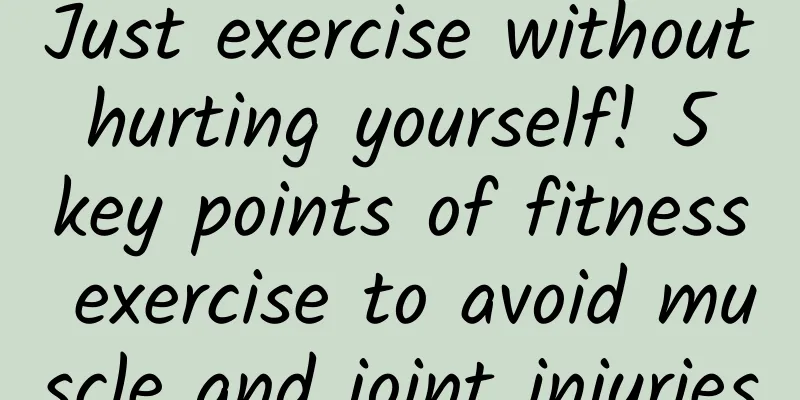Just exercise without hurting yourself! 5 key points of fitness exercise to avoid muscle and joint injuries

|
There are countless cases of fitness exercise injuries in rehabilitation clinics! Mr. Lin injured his wrist ligament due to "bench press"; Ms. Zhang suffered acute low back pain due to "deadlift". With the fitness trend and the popularity of gyms in recent years, more and more people are doing fitness exercises. In particular, "sarcopenia" has become an important issue in recent years. Fitness exercises for people aged 50+ have been widely recognized and promoted by government agencies and the public. (Photo courtesy of Taiwan Rehabilitation Medicine Association) Research shows that about 20-30% of people who exercise have been injured in the gym, with an average of 2.13 injuries. The number of patients seeking treatment at the rehabilitation department due to injuries caused by incorrect posture is also increasing day by day. The most common injured parts are shoulders (26-40.5%), followed by backs (24%) and knees (18%). The most common mechanism of injury is "overuse". 58% of the injured patients sought medical treatment due to injuries, and 11% of the cases even underwent surgery due to injuries, which in turn affected their life and motor functions. Among fitness sports injuries, taking the most common shoulder joint injury as an example, the most common cause of injury is incorrect posture and further deterioration of previous injuries due to improper treatment. Studies have shown that the chance of injury is significantly reduced if there is professional guidance. In addition, if you have not exercised for a long time, you are at high risk of injury when you first resume exercise. Other factors that increase the risk of injury during fitness exercises include age (older people are more susceptible to injury) and being overweight. Among fitness sports injuries, muscle and joint injuries are the most common. Therefore, when you are engaged in fitness exercises, if you experience improper joint swelling, muscle strain, and joint sprain, you should stop exercising immediately and receive proper evaluation and treatment to ensure that the injured part has stabilized or healed, and to find out the possible causes of the sports injury. In addition to "treating the symptoms" or relieving the symptoms, we also need to "treat the root cause" by correcting improper postures, and even adjusting the intensity and frequency! The author is also a strength trainer for the National Strength and Conditioning Association of the United States. He deeply understands that for some beginners, the introductory knowledge of weight (resistance) training is the only way to prevent injuries, which is extremely important. Here we sort out the basic solutions for correct posture, fitness process, etc.: Focus 1: Stable trunk - sitting and lying training What is a stable torso? During weight training, you must maintain a stable torso so that you can transfer power to the dumbbells or barbells through your body and achieve safe and optimal sports performance. If the torso is unstable, the barbell will easily shake or the force will not be transferred smoothly. It may also cause inappropriate muscle groups to be used, increasing the risk of injury. In addition to training the core muscles and directly training the stability of the trunk, the following simple rule can help maintain the correct posture - the "Five-Point Contact Rule": 1. Place your head firmly on a bench or back cushion. 2. Keep your shoulders and upper back firmly and evenly pressed against the bench or back cushion. 3. Sit evenly on the seat with your buttocks. (Don’t be inconsistent) 4. Place your right foot flat on the ground 5. Place your left foot flat on the ground The above five points "head, shoulders, back, hips, left foot, right foot" can stabilize and maintain the positions of these five body contact points at the start and throughout the movement phase, which can promote maximum trunk stability and spinal support, thereby reducing possible sports injuries. "Bench press" demonstrates the five-point contact rule: head, shoulders (upper back), buttocks, left foot and right foot. Maintain contact at the above five points to increase trunk stability. (Photo courtesy of Taiwan Rehabilitation Medicine Association) Focus 2: Stable trunk-standing training Like lying and sitting training, standing resistance training also requires a stable torso. Standing training usually requires the feet to be positioned slightly wider than the width of the hips, with the heels and soles of the feet in contact with the floor (not on tiptoe), which can achieve optimal athletic performance and reduce sports injuries caused by torso instability. "Deadlift" demonstrates a stable standing posture: feet are positioned slightly wider than hips, feet are in contact with the ground, and toes are not raised. (Photo courtesy of Taiwan Rehabilitation Medicine Association) Key point 3: Breathing control Breathing control is closely related to resistance training. Exercises are divided into "concentric contraction" and "eccentric contraction". It is generally recommended to inhale during eccentric contraction (more effort is exerted at this time, and human inhalation is a passive action, putting more effort on training muscles), and exhale during concentric contraction (less muscle effort at this time). For example, when doing a biceps curl, inhale as you straighten your elbow and exhale as you bend your elbow. This type of breath control can be applied to most resistance training exercises. Key point 4: Use of belt Some people use belts when doing weight training. When people who have just started exercising in the clinic see someone using a belt in the gym, they often ask if they need a fitness belt. What is its function? The function of a fitness belt is to maintain stable intra-abdominal pressure during weight training. Its suitability depends on the type of exercise and the intensity of weight training. It is generally recommended that you wear a belt during exercises that place stress on the lower back and during training that uses near-maximal or maximal loads. Therefore, a weight belt is not necessary for non-lower back exercises (biceps and leg muscle training), and it is not recommended to wear a belt for low to medium weight lower back exercises. Key Point 5: Sequentiality of Movement When many people first start exercising, they wonder which type of resistance training they should do first. According to the American College of Sports Medicine, the following are the recommendations for the order: 1. The principle of resistance training is to train large muscle groups first and then small muscle groups (large muscle groups are less likely to fatigue, while small muscle groups are more likely to fatigue) 2. Multiple joints and then single joint movement 3. High-intensity and then low-intensity exercise Key Point 6: Suggested Intensity and Progression of Intensity For the general population, the intensity should not be too high, and 8-15 reps is the standard. Too heavy an intensity may easily lead to sports injuries, while too light an intensity will not have much effect on increasing muscle strength. When can I add weight? The weight increase can follow the "2-for-2 Rule", which is the rule recommended by the American College of Sports Medicine and the National Strength and Conditioning Association for increasing load: If in two consecutive training sessions, the number of times a certain action can be completed exceeds the predetermined target number by 2 times (inclusive) or more, the weight of the action can be increased (2%-10%) in the next training session. The above is the basic knowledge for fitness people who are just starting weight training. In addition to the above guidelines, it is recommended to have a professional to teach the posture when starting each exercise for the first time. You must have a full understanding of the posture and movements of the training before starting training, gradually increase the intensity of fitness exercises, and avoid suddenly engaging in high-intensity fitness activities. These can effectively reduce the risk of related sports injuries. This article was provided by Taiwan Rehabilitation Medicine Association Author: Dr. He Wei-de, Director of Nankan Kangze Rehabilitation Clinic |
>>: How to eat Mid-Autumn Festival delicacies? Four principles to get rid of the burden
Recommend
How long can you live with cervical precancerous lesions?
How long can you live with cervical precancerous ...
What should I do if I have pelvic inflammatory disease? Remember not to blindly take medicine
After suffering from pelvic inflammatory disease,...
Light cold noodles contain hidden dangers. One plate of calories is 600 kcal
Summer is the best time to eat refreshing food. I...
To prevent cervical erosion, you must pay attention to understanding the cause
We often encounter patients with cervical erosion...
How to confirm that it is not an ectopic pregnancy
Go to the hospital for B-ultrasound examination t...
Experts explain the causes of cervicitis
As a type of gynecological disease, cervicitis ca...
His face is as green as a bamboo shoot! Lotus leaf oolong tea for weight loss and complexion
"You'll get fat as soon as you drink wat...
Does uterine fibroids affect life?
Does uterine fibroids have an impact on life? Ute...
Attention sports people! In addition to supplementing protein, we should also pay attention to what amino acids we eat
For those of us who exercise regularly, whether i...
Treatment of cervical erosion Is cervical erosion difficult to treat?
Cervical erosion is the most common inflammation ...
What are the prevention methods for vaginitis?
The occurrence of vaginitis has brought unspeakab...
What to do when you have menstrual pain
Women often experience abdominal pain during mens...
Quinoa becomes a new vegetable cocktail trend
In recent years, the superfood that has been love...
Dysfunctional uterine bleeding may be a process leading to menopause
Ms. Zhao, 46 years old, had intermittent and co...
Foot massage for health care and treatment of amenorrhea
[Introduction] Any woman who is over 18 years old...









